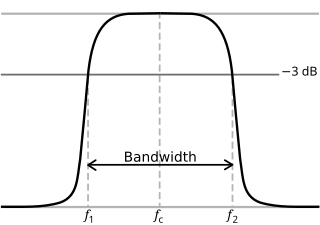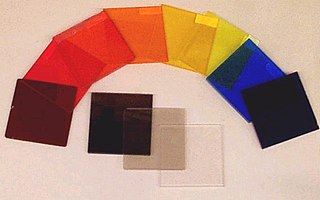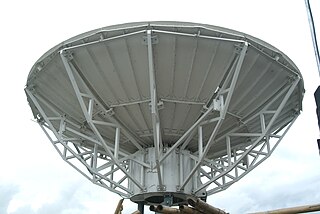In economics, the Gini coefficient, sometimes called Gini index, or Gini ratio, is a measure of statistical dispersion intended to represent the income or wealth distribution of a nation's residents, and is the most commonly used measurement of inequality. It was developed by the Italian statistician and sociologist Corrado Gini and published in his 1912 paper Variability and Mutability.

Microwaves are a form of electromagnetic radiation with wavelengths ranging from about one meter to one millimeter; with frequencies between 300 MHz (1 m) and 300 GHz (1 mm). Different sources define different frequency ranges as microwaves; the above broad definition includes both UHF and EHF bands. A more common definition in radio engineering is the range between 1 and 100 GHz. In all cases, microwaves include the entire SHF band at minimum. Frequencies in the microwave range are often referred to by their IEEE radar band designations: S, C, X, Ku, K, or Ka band, or by similar NATO or EU designations.

In physics and electrical engineering, a cutoff frequency, corner frequency, or break frequency is a boundary in a system's frequency response at which energy flowing through the system begins to be reduced rather than passing through.

In antenna theory, a phased array usually means an electronically scanned array, a computer-controlled array of antennas which creates a beam of radio waves that can be electronically steered to point in different directions without moving the antennas. In an array antenna, the radio frequency current from the transmitter is fed to the individual antennas with the correct phase relationship so that the radio waves from the separate antennas add together to increase the radiation in a desired direction, while cancelling to suppress radiation in undesired directions. In a phased array, the power from the transmitter is fed to the antennas through devices called phase shifters, controlled by a computer system, which can alter the phase electronically, thus steering the beam of radio waves to a different direction. Since the array must consist of many small antennas to achieve high gain, phased arrays are mainly practical at the high frequency end of the radio spectrum, in the UHF and microwave bands, in which the antenna elements are conveniently small.

Line-of-sight propagation is a characteristic of electromagnetic radiation or acoustic wave propagation which means waves travel in a direct path from the source to the receiver. Electromagnetic transmission includes light emissions traveling in a straight line. The rays or waves may be diffracted, refracted, reflected, or absorbed by the atmosphere and obstructions with material and generally cannot travel over the horizon or behind obstacles.

High frequency (HF) is the ITU designation for the range of radio frequency electromagnetic waves between 3 to 30 megahertz (MHz). It is also known as the decameter band or decameter wave as its wavelengths range from one to ten decameters. Frequencies immediately below HF are denoted medium frequency (MF), while the next band of higher frequencies is known as the very high frequency (VHF) band. The HF band is a major part of the shortwave band of frequencies, so communication at these frequencies is often called shortwave radio. Because radio waves in this band can be reflected back to Earth by the ionosphere layer in the atmosphere – a method known as "skip" or "skywave" propagation – these frequencies are suitable for long-distance communication across intercontinental distances and for mountainous terrains which prevent line-of-sight communications. The band is used by international shortwave broadcasting stations (2.31–25.82 MHz), aviation communication, government time stations, weather stations, amateur radio and citizens band services, among other uses.

Tomography is imaging by sections or sectioning, through the use of any kind of penetrating wave. The method is used in radiology, archaeology, biology, atmospheric science, geophysics, oceanography, plasma physics, materials science, astrophysics, quantum information, and other areas of science. The word tomography is derived from Ancient Greek τόμος tomos, "slice, section" and γράφω graphō, "to write". A device used in tomography is called a tomograph, while the image produced is a tomogram.

A monochromator is an optical device that transmits a mechanically selectable narrow band of wavelengths of light or other radiation chosen from a wider range of wavelengths available at the input. The name is from the Greek roots mono-, "single", and chroma, "colour", and the Latin suffix -ator, denoting an agent.

An optical filter is a device that selectively transmits light of different wavelengths, usually implemented as a glass plane or plastic device in the optical path, which are either dyed in the bulk or have interference coatings. The optical properties of filters are completely described by their frequency response, which specifies how the magnitude and phase of each frequency component of an incoming signal is modified by the filter.
Plasma stealth is a proposed process to use ionized gas (plasma) to reduce the radar cross-section (RCS) of an aircraft. Interactions between electromagnetic radiation and ionized gas have been extensively studied for many purposes, including concealing aircraft from radar as stealth technology. Various methods might plausibly be able to form a layer or cloud of plasma around a vehicle to deflect or absorb radar, from simpler electrostatic or radio frequency discharges to more complex laser discharges. It is theoretically possible to reduce RCS in this way, but it may be very difficult to do so in practice. Some Russian systems e.g. the 3M22 Zircon (SS-N-33) missile have been reported to make use of plasma stealth.
In particle physics, the parton model is a model of hadrons, such as protons and neutrons, proposed by Richard Feynman. It is useful for interpreting the cascades of radiation produced from QCD processes and interactions in high-energy particle collisions.
Minimum resolvable temperature difference (MRTD) is a measure for assessing the performance of infrared cameras, and is inversely proportional to the modulation transfer function.

The Dobson spectrophotometer, also known as Dobsonmeter, Dobson spectrometer, or just Dobson is one of the earliest instruments used to measure atmospheric ozone.
The San Marino Scale is a suggested scale for assessing risks associated with deliberate transmissions from Earth aimed to possible extraterrestrial intelligent life. The scale evaluates the significance of transmissions from Earth as a function of signal intensity and information content. The scale was suggested by Iván Almár at a conference in San Marino in 2005. The radio output of Jupiter, Saturn and Neptune is not considered in the model. The San Marino Scale was subsequently adopted by the SETI Permanent Study Group of the International Academy of Astronautics at its 2007 meeting in Hyderabad, India.
ISO 25178: Geometric Product Specifications (GPS) – Surface texture: areal is an International Organisation for Standardisation collection of international standards relating to the analysis of 3D areal surface texture.

A riometer is an instrument used to quantify the amount of electromagnetic-wave ionospheric absorption in the atmosphere. As the name implies, a riometer measures the "opacity" of the ionosphere to radio noise emanating from cosmic origin. In the absence of any ionospheric absorption, this radio noise, averaged over a sufficiently long period of time, forms a quiet-day curve. Increased ionization in the ionosphere will cause absorption of radio signals, and a departure from the quiet-day curve. The difference between the quiet-day curve and the riometer signal is an indicator of the amount of absorption, and is measured in decibels. Riometers are generally passive radio antenna operating in the VHF radio frequency range (~30-40 MHz). Electromagnetic radiation of that frequency is typically Galactic synchrotron radiation and is absorbed in the Earth's D region of the ionosphere.

Disilyne, Si
2H
2, is a metalloid hydride composed of silicon and hydrogen. Disilyne is not well-characterised, and it is kinetically unstable with respect to isomerisation. The most stable isomer is a dibridged singlet, named di-μH-disilyne, followed by a monobridged μH-disilyne. A third, unbridged singlet ismomer is predicted to exist before disilyne - disilenylidene.
Electron precipitation is an atmospheric phenomenon that occurs when previously trapped electrons enter the Earth's atmosphere, thus creating communications interferences and other disturbances. Electrons are trapped in the Van Allen radiation belt by Earth's magnetic fields and begin to spiral around field lines in the radiation belt. They may remain there for an indefinite period of time. When broadband very low frequency (VLF) waves propagate the radiation belts, the electrons exit the radiation belt and "precipitate" into the ionosphere where the electrons will collide with ions. Electron precipitation is regularly linked to ozone depletion. It is often caused by lightning strikes.
In cryptography, electromagnetic attacks are side-channel attacks performed by measuring the electromagnetic radiation emitted from a device and performing signal analysis on it. These attacks are a more specific type of what is sometimes referred to as Van Eck phreaking, with the intention to capture encryption keys. Electromagnetic attacks are typically non-invasive and passive, meaning that these attacks are able to be performed by observing the normal functioning of the target device without causing physical damage. However, an attacker may get a better signal with less noise by depackaging the chip and collecting the signal closer to the source. These attacks are successful against cryptographic implementations that perform different operations based on the data currently being processed, such as the square-and-multiply implementation of RSA. Different operations emit different amounts of radiation and an electromagnetic trace of encryption may show the exact operations being performed, allowing an attacker to retrieve full or partial private keys.















